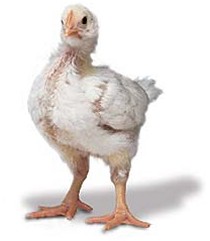Antibodies – The First Line of Defence
The following three animations illustrate, in a simplified form, the interaction of IBD virus and circulating neutralising antibodies.
The animations require a Flash player which is installed in most web browsers today. If they do not work, click here to download Flash or download and run the stand-alone executable version (MS Windows).
The animations are based on an infection with a virulent strain of IBD virus; however the same dynamics apply to vaccine strains. Vaccine strains must infect the bursa of Fabricius to induce immunity. If a high level of circulating antibodies (MDA – maternal derived antibody) neutralises the vaccine before reaching the bursa, the chicken is not immunized and thus remains susceptible to Gumboro infection at a later age.
Animation 1: IBDV – No Antibody
Animation sequence illustrates the course of infection of a pathogenic strain of Gumboro virus in a susceptible chicken, thus a chicken with no circulating antibodies to IBDV.
- The virus is ingested.
- Crosses the intestinal wall and enters the blood stream.
- The virus is transported in the bloodstream to the different internal organs, including the bursa of Fabricius.
- In the bursa there is massive viral replication, with subsequent bursal damage.
- A secondary viraemia occurs with clinical symptoms and possible death. High levels of virus can be detected in allorgans.
Animation 1: IBDV – No Antibody (Start animation by clicking on play button)

Animation 1: IBDV – No Antibody (276kb)
download MS Windows executable
Animation 2: IBDV – Low Antibody
Animation sequence illustrates the course of infection of a pathogenic strain of Gumboro virus in a chicken with a low to moderate level of circulating antibody to IBDV.
- The virus is ingested.
- Crosses the intestinal wall and enters the blood stream. In the bloodstream the virus is exposed to circulating antibodies.
- The antibodies neutralise a percentage of the virus. Thus less infectious virus is circulated to the different internal organs, including the bursa of Fabricius.
- In the bursa there is viral replication. However due to an initial lower infectious dose the subsequent bursal damage is only partial.
- A secondary viraemia occurs, but the level of virus circulating may be below that required to induce clinical symptoms.
- The result is no clinical gumboro, however dependant on the degree of bursal damage there is still immunosuppression.
Animation 2: IBDV – Low Antibody (Start animation by clicking on play button)

Animation 2: IBDV – Low Antibody (274kb)
download MS Windows executable
Animation 3: IBDV – High Antibody
Animation sequence illustrates the course of infection of a pathogenic strain of Gumboro virus in a chicken with a high level of circulating antibody to IBDV.
- The virus is ingested.
- Crosses the intestinal wall and enters the blood stream. In the bloodstream the virus is exposed to circulating antibodies.
- The antibodies neutralise the virus. Thus no or insignificant levels of infectious virus is circulated to the different internal organs, including the bursa of Fabricius.
- The result is no clinical gumboro or bursal damage. A healthy chicken!
Animation 3: IBDV – High Antibody (Start animation by clicking on play button)

Animation 3: IBDV – High Antibody (273kb)
download MS Windows executable

